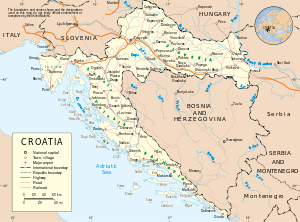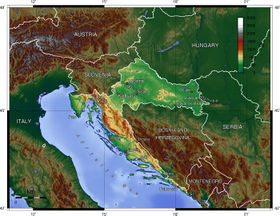Geography of Croatia
| Geography of Croatia | |
|---|---|
 |
|
| Continent | Europe |
| Region | Southeastern Europe |
| Area | 56,542 km2 (21,831.0 sq mi) 99% land 1 % water |
| Borders | Total land borders: 2,197 km |
| Highest point | Dinara 1,830 m |
| Lowest point | Mediterranean Sea 0 m |
| Longest river | Sava |

Croatia is located in Southeastern Europe (aka the western Balkans) between Bosnia and Herzegovina and Slovenia.[1][2] It borders the Adriatic Sea along its 5,835 km coastline. Its size is comparable to that of West Virginia or Nova Scotia. Croatia has a 932 km border with Bosnia and Herzegovina, a 670 km border with Slovenia, a 329 km border with Hungary, a 241 km border with Serbia (its Autonomous Province of Vojvodina entirely) and a 25 km border with Montenegro. Islands and coastal areas in Croatia have a Mediterranean climate while inland areas have temperate continental climate with hot summers with low overall humidity levels but frequent rainshowers and cold snowy winters. The local terrain is quite diverse given the size of the country. There are flat plains along the Hungarian border, low mountains and highlands near the Adriatic coastline and islands. Croatia's strategic location gives it control over most land routes from Western Europe to the Aegean Sea and the Turkish Straits. The country's natural resources include Petroleum, some coal, bauxite, low-grade iron ore, calcium, natural asphalt, silica, mica, clays, salt and hydropower.
Contents |
Details
Maritime claims
-
- Continental shelf: 200-m depth or to the depth of exploitation
- Territorial sea: 12 nmi (22.2 km; 13.8 mi)
Land use
-
- Arable land: 23.55%
- Permanent crops: 2.24%
- Other: 74.21% (1998 est.)
Irrigated land: 30 km² (1998 est.)
Environment
1. Natural hazards: destructive earthquakes
2. Current issues:
-
- Air pollution (from metallurgical plants) and resulting acid rain is damaging the forests
- coastal pollution from industrial and domestic waste;
- Landmine removal and reconstruction of infrastructure as a result of the 1991-1995 Croatian War of Independence.
3. International agreements:
-
- Party to: Air Pollution, Air Pollution-Sulfur 94, Biodiversity, Climate Change, Desertification, Endangered Species, Hazardous Wastes, Law of the Sea, Marine Dumping, Nuclear Test Ban, Ozone Layer Protection, Ship Pollution (MARPOL 73/78), Wetlands
- Signed, but not ratified: Air Pollution-Persistent Organic Pollutants, Climate Change-Kyoto Protocol
Climate
Croatia has a mixture of climates. In the north and east it is continental, Mediterranean along the coast and a semi-highland and highland climate in the south-central region. Istra has a temperate climate, while the Palagruža archipelago is home to a subtropical climate.
See also
- Croatia
- Extreme points of Croatia
- List of rivers of Croatia
- List of islands of Croatia
- List of cities in Croatia
References
- ↑ "Identity Card / Information". Government of the Republic of Croatia. http://www.vlada.hr/en/about_croatia/information/identity_card. Retrieved 2010-04-26.
- ↑ "The World Factbook - Croatia". Central Intelligence Agency. https://www.cia.gov/library/publications/the-world-factbook/geos/hr.html.
External links
|
|||||||||||||||||||||||||||||
|
||||||||||||||
|
||||||||||||||
|
||||||||||||||||||||
